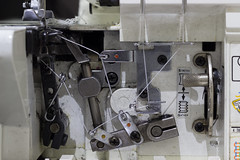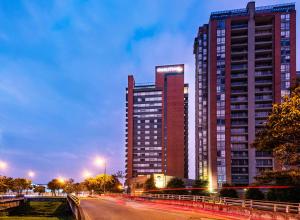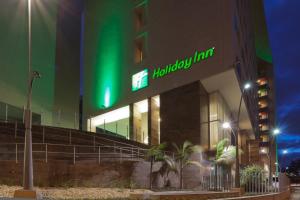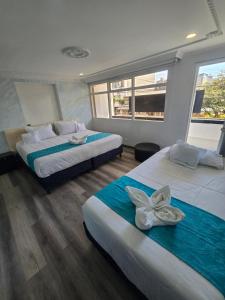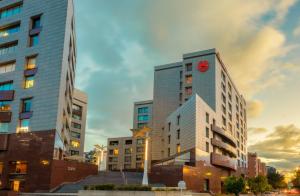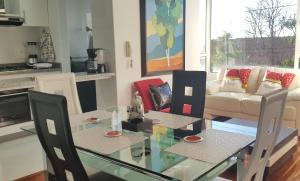TransMilenio
TransMilenio is a bus rapid transit (BRT) system that serves Bogotá, the capital of Colombia, and Soacha. The system opened to the public in December 2000, covering Caracas Avenue and 80 street. Other lines were added gradually over the next several years, and as of 2022, 12 lines totalling run throughout the city. It is part of the city's Integrated Public Transport System (Sistema Integrado de Transporte Público sitp in Spanish), along with the urban, complementary and special bus services operating on neighbourhoods and main streets.
It was inspired by Curitiba's Rede Integrada de Transporte (Integrated Transportation Network). TransMilenio consists of several interconnected BRT lines, with raised floor stations in the center of a main avenue, or "troncal". Passengers typically reach the stations via a bridge over the street. Usually four lanes down the center of the street are dedicated to bus traffic. The outer lanes allow express buses to bypass buses stopped at a station.
Users pay at the station entrance using a smart card, pass through a turnstile, and wait for buses inside the station, which is typically 5 m wide. The bus and station doors open simultaneously, and passengers board by simply walking across the threshold. The elevated station platform and the bus floor are at the same height.
In the beginning most buses were diesel-powered, purchased from such manufacturers as the Colombian-Brazilian company Marcopolo-Superior, German conglomerate Mercedes-Benz, and Swedish companies such as Volvo and Scania. The buses were articulated and had a capacity of 160 passengers each. In May 2007, a new, larger bi-articulated bus, with capacity for 270 passengers, was presented to the public. TransMilenio buses are not equipped with transponders to give them priority at traffic signals; regret over this fact was voiced by former general manager of the system, Angelica Castro.
As of the 4th quarter of 2021, 1,759 buses on average were circulating on the trunk line system. An additional set of 800 regular buses, known as "feeders" (alimentadores in Spanish), carry passengers from certain important stations to many different locations that the main route does not reach. Unlike the main TransMilenio buses, feeders operate without dedicated lanes, are not articulated and are either green or blue (regular TransMilenio buses are red). There is no additional fare to use the feeder buses.
There are 22 bicycle parking facilities in main TransMilenio stations with 6,059 parking spaces to facilitate cyclists using the system.
8 BRT corridors were certified in 2013 to meet the BRT STANDARD with excellence: Autonorte and Caracas silver, Americas, Calle 80, Eldorado, NQS and Suba gold.
History
Before TransMilenio, Bogotá's mass transit "system" consisted of thousands of independently operated and uncoordinated mini buses. There was also a plan for a network of elevated highways throughout Bogotá, and plans to build a subway as Medellín had done seven years prior. When Enrique Peñalosa was elected mayor he cancelled these projects and oversaw the construction of the initial TransMilenio system at a fraction of the cost.
Within three years after the initiation of the project, the first phase opened in December 2000. A second phase has been completed, and a third is underway. Prior to construction, a 30 km trip by public transport would take 2 hours and 15 minutes in 1998; the same trip using TransMilenio now takes 55 minutes.
The mayor created a special company to build the project and run the central system. The operational design of TransMilenio was undertaken by transport consultants Steer Davies Gleave with the financial structuring of the project led by Capitalcorp S.A., a local investment bank. Most of the money required to build TransMilenio was provided by the Colombian central government, while the city of Bogotá provided the remaining 30%.
Other cities are building systems modelled on Transmilenio, for example, Mexico City, and Transantiago in Santiago, Chile, but the difference is that in these cities the system is complemented with a Rapid transit system.
TransMilenio stations comply with easy access regulations because they are elevated and have ramps leading to the entrance. The alimentadores (feeders) are normal buses without handicapped accessibility. A lawsuit by disabled user Daniel Bermúdez caused a ruling that all feeder systems must comply with easy access regulations by 2004, but this has not happened yet.
2006 protests
On May 2 and 3, 2006, several groups of bus drivers not associated with TransMilenio held a strike, protesting against some elements and consequences of the system. They disagreed with the amount of monetary compensation that they would receive in exchange for the disposal of old buses (10 to more than 20 years old), traffic restrictions on the TransMilenio main lines, and a new Pico y Placa Ambiental in some city areas, that would restrict the schedules of buses older than 10 years to early morning hours to reduce pollution in the city.
Some of the larger bus companies which participate in TransMilenio also retired their conventional bus lines during the strike. Public transportation ground to a halt in much of the city. Although TransMilenio and a number of other buses continued operating, they could not cope with all of the demand. Acts of individual intimidation and violence against some private vehicles, TransMilenio and conventional buses occurred during the strike, as well as clashes between some of the strikers and the police.
Bogotá's Mayor Luis Eduardo Garzón condemned the strike, firmly defended all of the measures as necessary for the city's transportation future, and stated that he was only willing to discuss the specific details of their implementation, as well as a further democratization of TransMilenio's operations, after the situation calmed down. During the second and final day of the strike, the local administration, the strikers and their companies agreed to begin talks.
During the strike, some protests included users of TransMilenio who complained because the buses were passing at a very low frequency. Several stations became so filled up that some people fell from them into the street. Even after the strike ended, some TransMilenio passengers have subsequently protested because they still find aspects of the system to be inefficient and uncomfortable.
2012 protests
Due to the relatively high price, overcrowding, and delays in the routes hundreds of people mostly students protested and some vandals looted and broke windows on March 9, 2012, causing half a million dollars of damage and 11 injuries. The vandals were confronted and detained by riot police.
Infrastructure
TransMilenio has 12 lines serving 152 stations in the cities of Bogotá and Soacha:
- Caracas between Calle 76 and Tercer Milenio: 14 stations
- Autonorte between Terminal and Héroes: 17 stations
- Suba between Portal de Suba and San Martín: 14 stations
- Calle 80 between Portal de la 80 and Polo: 14 stations
- NQS Central between La Castellana and Tygua - San José: 13 stations
- Américas between Portal de Las Américas and Avenida Jiménez: 18 stations (including Ricaurte station)
- NQS Sur between Comuneros and San Mateo: 17 stations
- Caracas Sur between Hospital and Portal de Usme and Portal del Tunal: 16 stations
- Eje Ambiental between Museo del Oro and Universidades: 3 stations
- Calle 26, between Portal Eldorado and Centro Memoria: 13 stations
- Carrera Décima between Portal 20 de Julio and San Diego: 10 stations
- Carrera Séptima: Museo Nacional: 1 station
Since the May 2006 expansion, the TransMilenio route system has changed dramatically, with new sections added to the system. Instead of being numbered, routes have a combination of letters and numbers. In order to fill the information gap, TransMilenio made available an interactive guide that includes routes, stations, nearby places and route combinations.
New lines have been constructed, including one on Calle 26 (Downtown-West (Airport)) and the other on Carrera 10 (Downtown-South).
Construction of a new line in Carrera 7 (North-Downtown) is under consideration. This has been criticized as there are certain locations where the system might not fit.
There are six types of stations:
- Sencillas (Simple): local service stations, located approximately every 500 m
- De transferencia (Transfer): allow transfer between different lines through a tunnel
- Sin intercambio (No transfer): do not allow transfer between lanes (north-south, south-north, west-east, east-west); located in the Autopista Norte (due a stretch of the way), Tunal and 6th Street ramification (due water channels).
- Intermedias (Intermediate): service both feeder and trunk line.
- Cabecera (Portal): near the entrances to the city. In addition to feeders and articulated buses, intercity buses from the metropolitan area also arrive at these stations.
- Paraderos bus dual (dual-bus stop): located in the streets, these stops don't have turnstiles, electronic boards and the floor level is the same of the street; served by buses with station-level and street-level doors. These stops are located in the pretrunk corridors (AK 7, AV Caracas, AV Suba, AC 80, AV El Dorado).
All stations have electronic boards announcing the approximate arrival time of the next bus. Wait times are short as there is usually a bus serving the station. There are also station attendants to provide assistance to the passengers, and posted system maps.
Older services
The trunk system had three types of services:
- The Regular (Corriente) stopped at all stations.
- The Express (Expresos) only stopped at the stations determined in its route.
- The Super Express (Super Expresos) was established since the end of 2005 by the expansion of the system. Of these there were two classes:
- The Asymmetric (Asimetrico) covered the system in one direction. The 201 and 300 went from north to south and the 200 and 301 went from south to north. These services were only in service at peak hour…
Hotels TransMilenio
Looking for places related to TransMilenio?
Those are other destinations to find places related to TransMilenio:
- Simón Bolívar Park
- National University…
- TransMilenio
- Bogotá Botanical Ga…
- Estadio El Campín
- El Salitre
- Comercial Calima
- Salitre Mágico
- Corferias
- Coliseo Cubierto el…
- University City of …
- Mundo Aventura
- Complejo acuático S…
- Museo de los Niños
- Humedal de Capellan…
- Internacional de Fí…
- metropolitano El La…
- Maloka Museum
- El Renacimiento
- de Alto Rendimiento
- Barrios Unidos
- Palacio de los Depo…
- Sauzalito
- Plaza de los Artesa…











